A TV indoor antenna is a simple device that receives a television signal. It is used in the building and installed on a television receiver, to which it is connected with a special coaxial cable. This type of receiving device differs from other types of antennas in its simple design and low cost.
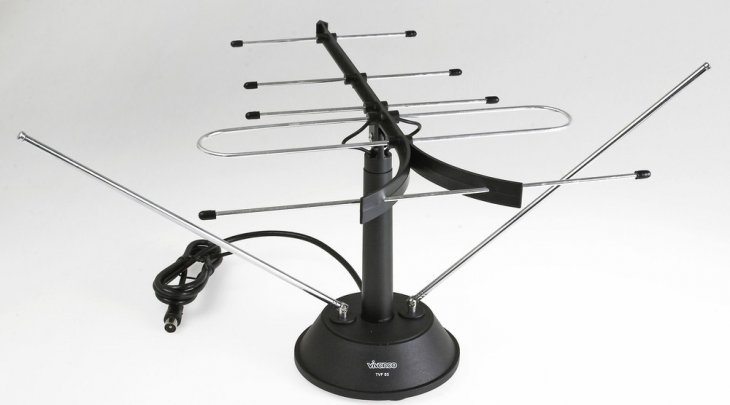
The advantages of a home wave receiver:
- low price;
- simplicity of installation and connection;
- compact sizes;
- the possibility of free movement if necessary.
The main disadvantages:
- each channel has to be configured separately;
- works only in the immediate vicinity of the broadcaster;
- sensitive to obstacles in the form of buildings, plants, rainfall and so on;
- It does not provide a good quality signal without interference.
Content
What does an antenna need to “catch” a signal well?
The reception efficiency and signal quality depend on the following conditions:
- At what distance from the repeater is the indoor antenna. A repeater is a powerful antenna that not only receives a signal, but also broadcasts or transmits it to space. A repeater is also called a television tower. A separate transceiver is installed in each region or locality. The farther away from the tower the wave receiver will be, the worse it will pick up the signal;
- on the type of wave receiver and the presence of additional devices that amplify the signal;
- at what level of height is the device located relative to the television tower;
- from the presence of obstacles between the tower and the antenna and their features. This refers to buildings and their height, landscape, vegetation;
- from the location of the wave receiver in the building. Most often they are installed on the TV itself or on the nearest window, which allows you to improve the characteristics of the received signal.
Indoor antennas: main types and description
The wave receivers used in the building are divided into several types according to the design features and the maximum wavelength that they can catch.
- The meter antenna is the simplest representative of home receivers. Able to pick up a wave signal that is in the meter range. It is a structure consisting of a stand, which houses a transformer with two movable "mustaches" in the form of thin telescopic rods, and a cable connected to the TV. Such a design for receiving a signal will show a good result only if it is installed at the closest distance from the transmitting tower. Meter wave receivers are not popular among buyers, as modern TV channels have almost completely switched to digital broadcasting format. About five Russian channels remained in the meter range.
- A decimeter or loop antenna is a type of receiver that works with a decimeter wave range. It is a device consisting of a base, an open loop frame and cable for connecting to a set-top box or to a TV. This type of receiver is capable of providing a good signal at a distance from the broadcaster up to 30 km.
- A hybrid receiver (all-wave) is a type of device whose design allows you to receive both meter and decimeter waves of a television signal. Convenience lies in the ability to switch between ranges if necessary.
- A passive wave receiver is a common device for capturing a signal without additional options to enhance the sensitivity and efficiency of wave perception.
- Active antenna for TV - a device that comes with a special amplifier to improve the quality of the received signal.Receivers with an amplifier are used at a great distance from the broadcaster tower or in cases where the signal must be divided into several TVs. Since the separation of the signal quality deteriorates.
The most common home antenna for the TV, capable of picking up digital TV signals. Therefore, we consider this type of wave receiver in more detail.
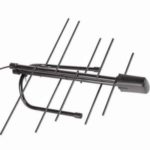 | 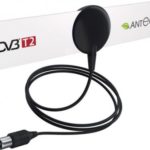 | 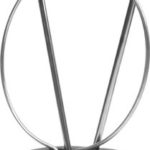 |  | 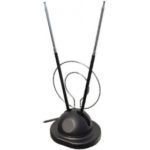 |
|
| Title | DVB-T2 Rexant | REMO Anteco BAS-5110 | HARPER ADVB-2111 | HAMA H-121650 | D-Color DCA-109 |
| Working range | Uhf | UHF / VHF | VHF / UHF / FM | ||
| Receive DVB-T / DVB-T2 | Yes | Yes | Yes | Yes | |
| Price | from 300 rub. | from 370 rub. | from 390 rub | from 800 rub | from 240 rub |
Home Digital Antenna: Features of Choice
Digital indoor antennas for a television are a form of wave receivers that receive a decimeter wave signal. In another way, this type of antenna is called DVB / T2 format receivers. That is, in fact, these are the same decimeter antennas.
In order for a TV to be able to receive and convert a digital television signal, the installation of a special DVB / T2 receiver is required. Some TVs already have a receiver that will receive digital television data.

How to choose a TV antenna that can receive a digital signal?
- First, determine whether a digital broadcast format is supported in a given region;
- check the distance from the repeater to the installation location of the wave receiver. Such information can be found on special sites or through a search engine;
- labeling on the packaging usually indicates the type of receiver for various television broadcast formats. If it is indicated that an antenna of the DMV type is for receiving an ether signal, this does not mean that for DVB / T2 it is necessary to buy a separate wave receiver. Since any UHF wave receiver can catch a digital television signal in the presence of a built-in or external receiver;
- the presence of a cable, stand for installation or mounts for hanging the receiver.
It is quite difficult to make any rating of antennas of this type, since a model that has proved to be excellent under certain conditions will not cope with the basic functions with minor changes in these conditions.
Therefore, we consider some models, most of which had better performance under different installation conditions.
- Model of a wave receiver with Mini Digital amplifier from the Saratov electromechanical plant "Remo". The device is a frame with small suction cups for attaching to a window and a stand in the form of a small box. Installation requires a power connection for the amplifier. The kit also includes a three-meter cable for connecting to a TV. Mini Digital is designed to receive a DMV signal, and therefore DVB / T
- Sirius series 2.0. - Home antenna on a stand without an amplifier. Designed to receive decimeter waves. The area declared by the manufacturer is up to 45 km.
- Denn DAA 238 series Chinese wave receiver. The model is equipped with an amplifier and is capable of receiving up to 20 television channels plus about three radio channel signals.

What to do if the indoor antenna does not “catch”
The poor quality of the received signal does not always mean that the design of the receiver is inefficient. Before changing the purchased wave receiver, you need to try to perform some actions. Perhaps they will help improve the quality of the received signal:
- Change the height of the "mustache" or the device itself. Some interference may not transmit the signal at the level at which the antenna is installed. It happens that changing the installation height on the TV or on the window leads to an improvement in the signal.
- If the antenna is mounted on a plastic window, then the metal-plastic construction of the window itself can interfere. In this case, the antenna can be mounted on an additional stand or mounted on the glass.
- Change the angle of rotation of the entire device or its moving parts. Sometimes the perpendicular arrangement of the antenna relative to the signal source gives a tangible improvement in quality.
- It is necessary to change the position of the device or its angle relative to the repeater smoothly, as it happens that even a shift of 5 millimeters affects the signal.
If all the necessary settings have been made, but the signal has not been "caught", or it turned out that the distance to the translator tower is too great, in this case a street antenna for the TV will be a good alternative.
What are outdoor antennas?
The design of such devices is more complex, but, like indoor ones, they are designed to receive the broadcast television signal. There are meter, DMV and DVB / T2. To install street wave receivers, you need a special coaxial cable with reinforced insulation and a sufficient level of height. The farther the tower is, the higher you need to install such an antenna.
In the places farthest from the television towers, it is better to install a satellite dish. A parabolic antenna, or “dish”, is designed to receive television and radio signals broadcast by the satellite. For this type of antenna to work, you need a special tuner and a coaxial cable. The dimensions of the dish are selected depending on the region where it will be installed, as well as on the working range of the satellite’s radio frequency signal, to which the device will be tuned.
In conclusion, I would like to note that the purchase of an expensive antenna does not guarantee excellent quality of the received signal. Since, in addition to the characteristics of the receiving device itself, environmental factors are equally important, which have a significant effect on the attenuation, reflection and transmission of waves in space. Therefore, it is impossible to unequivocally call any specific antenna model good or bad. In this case, when buying, you must, first of all, be based on the features of the area where the device will be installed.
I like the Harper ADVB-2120. In the city it catches normally, and most importantly - very pretty)))
26.300 from the city. Caught Deltas active and passive, Denn together with the receiver, catch dipoles, in the literal sense and as beer cans. I will try the zigzag frames. I will try the analogue web of Kharchenko, the antenna of Kovachev, etc., etc. etc .. Greetings from Smolensk with Smolensk.